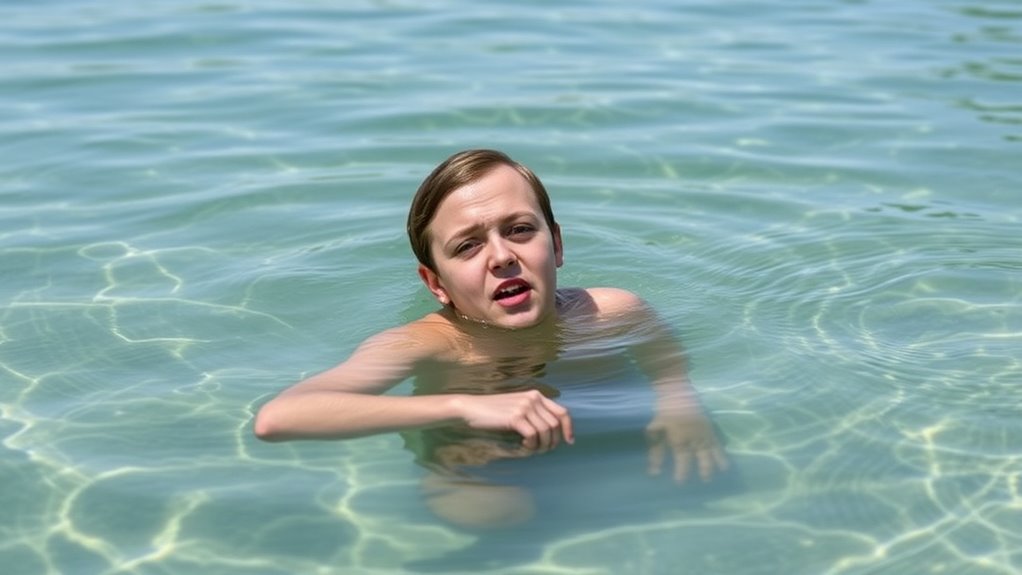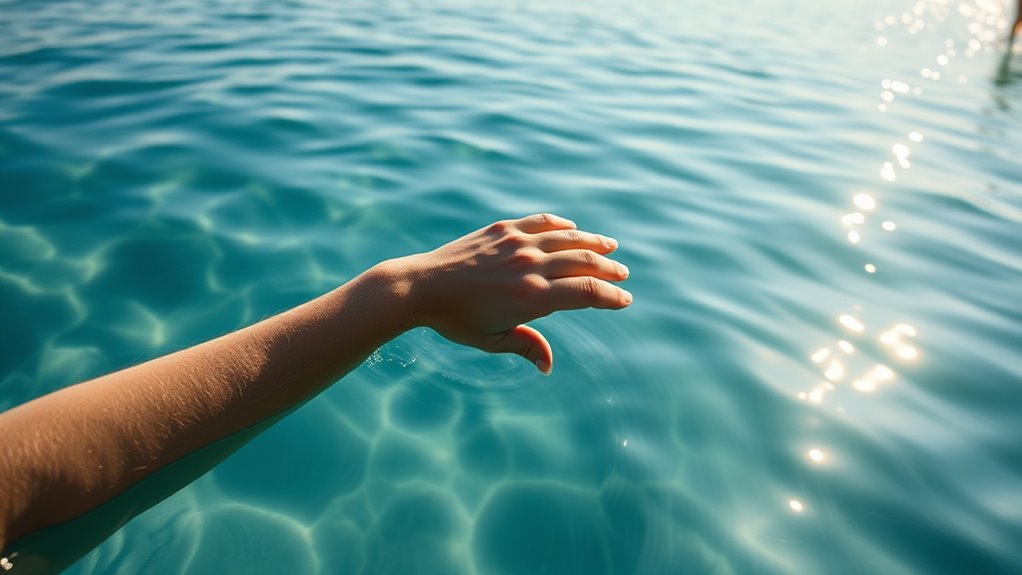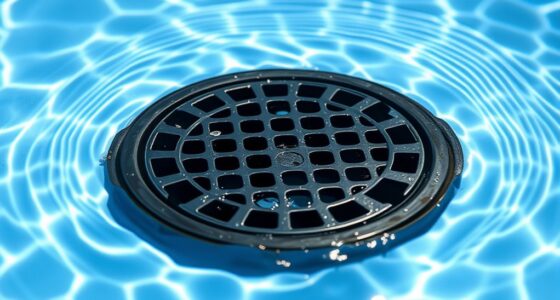Watch for subtle signs like small, jerky underwater movements, quiet struggling, or body positions that seem strange or tense. If someone’s face stays just above water with wide, unfocused eyes or if they appear to float passively without splashing or calling for help, they might be in trouble. Recognizing these quiet cues can save a life—continue to learn more about how to identify these hidden signs.
Key Takeaways
- Watch for minimal or irregular movements beneath the water surface that indicate silent struggling.
- Observe facial expressions: distressed, glassy eyes, and open mouth without noise or splashing.
- Note if the person remains in strange, rigid positions or floats passively without apparent effort.
- Look for quick head turns or tilts underwater, signaling breathing attempts or distress.
- Remember that absence of splashing, shouting, or waving does not mean the swimmer is safe.

Drowning often happens silently, making it difficult to recognize when someone is in trouble. Unlike the dramatic scenes often portrayed in movies, real-life drownings rarely involve loud calls for help or obvious splashing. Instead, victims may exhibit subtle signs, and understanding these can be lifesaving. One of the key indicators is observing submerged movements. When someone is drowning, they might not be flailing or shouting for help but instead show minimal or odd movements beneath the water’s surface. These can include slow, irregular strokes or a lack of coordinated effort to stay afloat. Sometimes, their body might appear to be in a strange, awkward position—arms extended or pressed against the water, trying to keep the head above the surface. These submerged movements are often accompanied by silent struggles, where the person’s distress is hidden beneath the water, making it easy to overlook. Additionally, the person may exhibit a panicked or distressed facial expression, even if no noise is made, indicating they are overwhelmed.
You need to be especially alert to these silent struggles. The person may seem to be struggling without making noise or obvious signs of distress. They might keep their head low or tilt it back, with their face remaining just above the water line. Their eyes could appear glassy or unfocused, and their body may stay rigid or remain in a fixed position for an extended period. Often, they won’t be able to call for help because they’re conserving energy or are simply overwhelmed. Their mouth may stay open in a silent gasp, or they may turn their head quickly to get a breath before sinking again. These signs can be very subtle but are essential to recognize early.
It’s imperative to remember that the absence of splashing or yelling doesn’t mean someone is safe. Drowning victims often cannot scream or wave for help because their energy is drained, and their focus is on survival. They may appear to be floating passively, but in reality, they’re fighting to stay conscious. If you notice a person who seems to be floating motionless or making small, jerky movements underwater, don’t wait for more obvious signs. Keep a close watch, and if you suspect trouble, act immediately. Reach out with a rescue device or call for help. Recognizing these silent signs of drowning can make all the difference in saving someone’s life before it’s too late. Being familiar with drowning cues, especially the silent ones, can help you respond quickly and effectively in emergencies.
Frequently Asked Questions
Can a Person Drown Silently Even if They Appear Calm?
You might wonder if someone can drown silently while appearing calm. In water safety, silent distress is common; a swimmer can struggle without obvious thrashing or shouting. They may keep a calm face but be in danger of drowning. Always watch for subtle signs like mouth opening, minimal movements, or trying to keep head above water. Recognizing these silent signs helps prevent tragedy, so stay alert and vigilant around water.
How Long Does Someone Typically Take to Drown After Showing Silent Signs?
You wonder about the drowning timeline after silent drowning signs appear. Typically, it can take just a few minutes for someone to drown once they show silent drowning signs, as their struggle may not be obvious. Silent drowning can happen quickly because distress often progresses fast, and the person may not call for help. Stay alert and watch for subtle cues, since recognizing these signs early can save lives.
Are Children More Likely to Exhibit Silent Drowning Signs Than Adults?
Think of children as quiet lakes—sometimes their behavior masks trouble. Yes, kids are more likely to exhibit silent drowning signs than adults because of their limited swimming skills and unpredictable child behavior. They might struggle without splashing or calling for help. You need to watch closely, as their subtle behaviors—like treading water without noise—can be the first signs they’re in danger. Stay alert and act quickly.
What Are the Most Overlooked Silent Signs of Drowning?
You might overlook subtle behavioral cues like a swimmer’s sudden stillness or inability to respond, which are key silent signs of drowning. Unnoticed physical symptoms, such as struggling to keep their head above water or inconsistent movements, can also be missed. Pay close attention to these signs, as they often appear quietly and can be mistaken for normal behavior. Recognizing these overlooked cues can be lifesaving in critical moments.
How Can Bystanders Effectively Respond to Silent Drowning Emergencies?
Oh, sure, you can just hope someone else notices and acts—because ignoring a silent drowning is so much fun. Instead, be proactive with emergency response; spot those subtle signs, shout for help, and call emergency services immediately. Your quick bystander actions could save a life. Stay alert, don’t hesitate, and remember, your prompt response makes all the difference when someone’s in trouble underwater.
Conclusion
Remember, drowning often whispers in silence like a sinking ship’s bell—unnoticed yet urgent. When you see a swimmer struggling silently, their quiet struggle is a call for help. Be the lighthouse that stands firm against the storm, guiding them safely to shore. Recognize the subtle signs before they fade into the depths. Your vigilance can turn a silent cry into a lifeline, shining a beacon of hope in the darkest waters.










